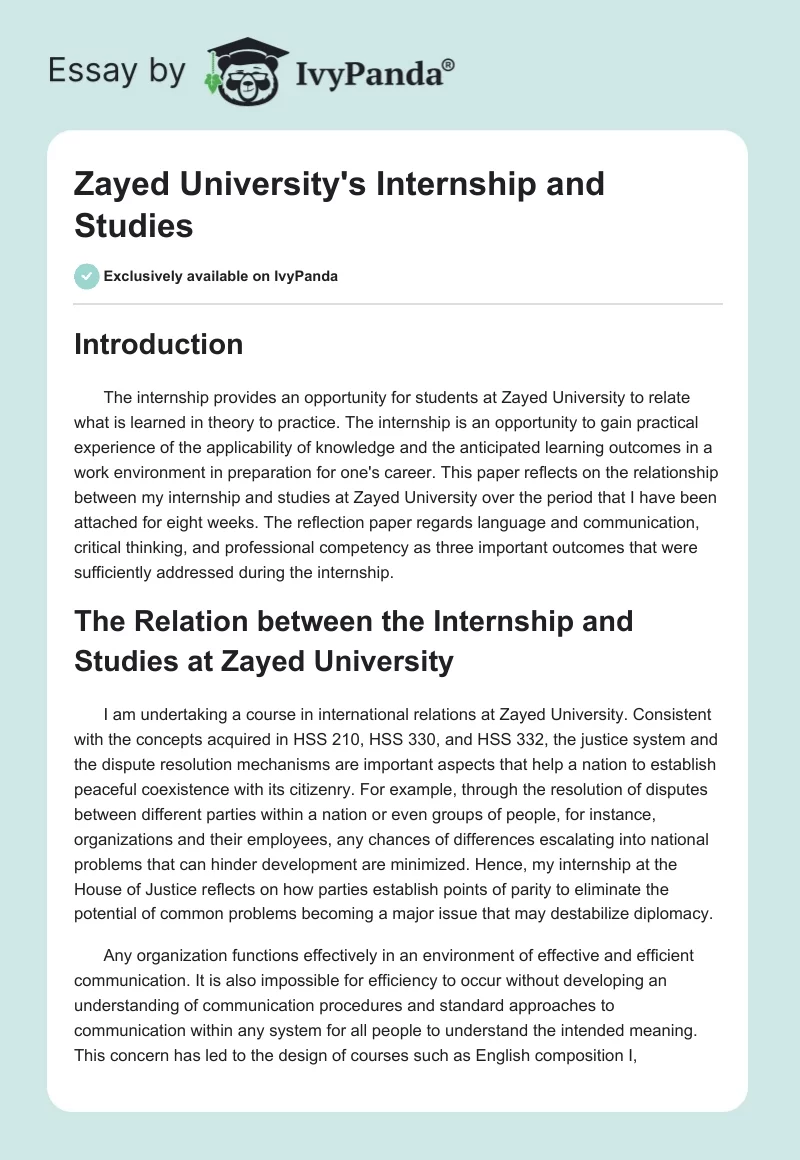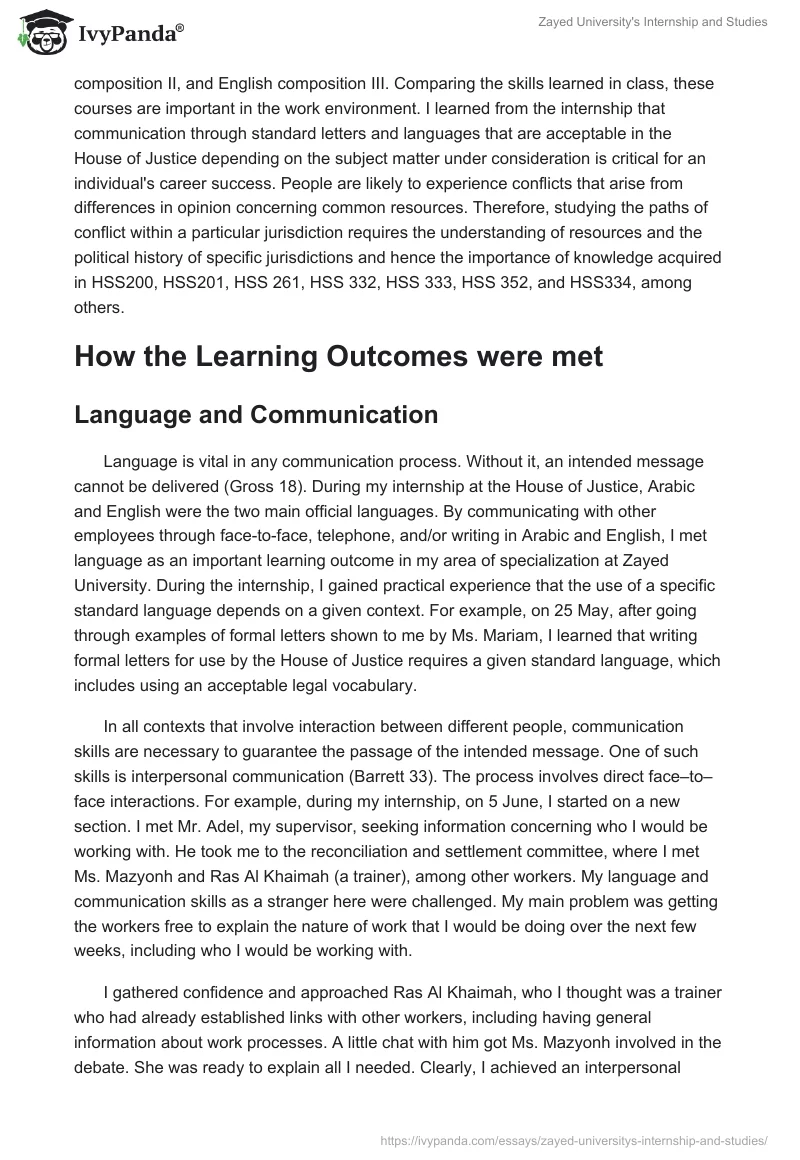Introduction
The internship provides an opportunity for students at Zayed University to relate what is learned in theory to practice. The internship is an opportunity to gain practical experience of the applicability of knowledge and the anticipated learning outcomes in a work environment in preparation for one’s career. This paper reflects on the relationship between my internship and studies at Zayed University over the period that I have been attached for eight weeks. The reflection paper regards language and communication, critical thinking, and professional competency as three important outcomes that were sufficiently addressed during the internship.
The Relation between the Internship and Studies at Zayed University
I am undertaking a course in international relations at Zayed University. Consistent with the concepts acquired in HSS 210, HSS 330, and HSS 332, the justice system and the dispute resolution mechanisms are important aspects that help a nation to establish peaceful coexistence with its citizenry. For example, through the resolution of disputes between different parties within a nation or even groups of people, for instance, organizations and their employees, any chances of differences escalating into national problems that can hinder development are minimized. Hence, my internship at the House of Justice reflects on how parties establish points of parity to eliminate the potential of common problems becoming a major issue that may destabilize diplomacy.
Any organization functions effectively in an environment of effective and efficient communication. It is also impossible for efficiency to occur without developing an understanding of communication procedures and standard approaches to communication within any system for all people to understand the intended meaning. This concern has led to the design of courses such as English composition I, composition II, and English composition III. Comparing the skills learned in class, these courses are important in the work environment. I learned from the internship that communication through standard letters and languages that are acceptable in the House of Justice depending on the subject matter under consideration is critical for an individual’s career success. People are likely to experience conflicts that arise from differences in opinion concerning common resources. Therefore, studying the paths of conflict within a particular jurisdiction requires the understanding of resources and the political history of specific jurisdictions and hence the importance of knowledge acquired in HSS200, HSS201, HSS 261, HSS 332, HSS 333, HSS 352, and HSS334, among others.
How the Learning Outcomes were met
Language and Communication
Language is vital in any communication process. Without it, an intended message cannot be delivered (Gross 18). During my internship at the House of Justice, Arabic and English were the two main official languages. By communicating with other employees through face-to-face, telephone, and/or writing in Arabic and English, I met language as an important learning outcome in my area of specialization at Zayed University. During the internship, I gained practical experience that the use of a specific standard language depends on a given context. For example, on 25 May, after going through examples of formal letters shown to me by Ms. Mariam, I learned that writing formal letters for use by the House of Justice requires a given standard language, which includes using an acceptable legal vocabulary.
In all contexts that involve interaction between different people, communication skills are necessary to guarantee the passage of the intended message. One of such skills is interpersonal communication (Barrett 33). The process involves direct face–to–face interactions. For example, during my internship, on 5 June, I started on a new section. I met Mr. Adel, my supervisor, seeking information concerning who I would be working with. He took me to the reconciliation and settlement committee, where I met Ms. Mazyonh and Ras Al Khaimah (a trainer), among other workers. My language and communication skills as a stranger here were challenged. My main problem was getting the workers free to explain the nature of work that I would be doing over the next few weeks, including who I would be working with.
I gathered confidence and approached Ras Al Khaimah, who I thought was a trainer who had already established links with other workers, including having general information about work processes. A little chat with him got Ms. Mazyonh involved in the debate. She was ready to explain all I needed. Clearly, I achieved an interpersonal communication learning outcome. For the rest of my stay in this section, I had no problems when communicating with other workers and even my supervisor about any issue pertinent to work and work processes, whether seeking direction on how to do things in the right manner or seeking clarification or correction.
Critical Thinking
Over the internship period, I learned that challenges in the work environment arise when an individual must provide solutions to specific problems. Over my internship, the decision to act in a particular manner was followed by some repercussions, which would prove earlier decisions right or wrong. Nevertheless, all that I would endeavor was to make the right decisions. This process does not require dogmatic reasoning but solid and precise decisions supported by reason. The process of making subtle decisions warrants critical thinking. This process is instrumental in separating right from wrong (Paul and Elder 93). Criticality in thinking implies that one examines the decisions carefully in an attempt to segregate the right from wrong decisions, which are likely to invite trouble in the short or long run (Pavlidis 81). For example, in my internship, I had the noble responsibility of preplanning my work and training on daily chores. I also had the responsibility of thinking through my decisions to ensure that I stick to those decisions that would not plunge me into conflicts with the organization.
Professional Competency
Leadership is an important aspect of professional competency. Leadership functions to inspire followers to work collectively to achieve specific goals. An organizational practice not only influences the followers (employees) but also leaders in a manner that ensures that organizational objectives are achieved through change (Kedarnath 7). It integrates and intertwines followers and leaders while at the same time influencing organizational objectives, missions, and other organizational stakeholders (Dye 47). While leading, followers must be involved. Leaders operate as strategists, communicators, and motivators through empowerment. To this extent, during my internship, I sought opinion and guidance from other employees who had long-term experience in executing specific chores before I made any decision to execute them. This plan ensured that all other people who I worked with within any section of the House of Justice were part of what I was doing. Hence, if anything went wrong, I would be accountable because of failing to follow advice.
Conclusion
My internship at the House of Justice was phenomenal in helping to put theory acquired in my studies as an international relations student at Zayed University into practice. The 8-week internship helped me to improve my language and communication skills by participating in practical interpersonal communication, including the use of language in verbal and written communication. The internship was an impeccable opportunity to put my professional competencies such as leadership into practice.
Works Cited
Barrett, Deborah. Leadership Communication, New York, NY: McGraw-Hill, 2006. Print.
Dye, Carson. Leadership in Healthcare: Essential Values and Skill, New York, NY: Health Administration Press, 2010. Print.
Gross, Martins. “Staying on Message.” Community College Journal 81.1(2010): 17-19. Print.
Kedarnath, U’khand. “The influence of Leaders’ Implicit Followership Theories on Employee Outcomes.” Organizational Behavior and Human Decision Processes 7.5(2011): 1-24. Print.
Paul, Richard, and Linda Elder. Critical Thinking Tools for Taking Charge of Your Learning and Your Life, New Jersey, NJ: Prentice-Hall Publishing, 2006. Print.
Pavlidis, Periklis. “Critical Thinking Dialectics: A Hegelian-Marxist Approach.” Journal for Critical Education Policy Studies 8.2(2010): 74-102. Print.


